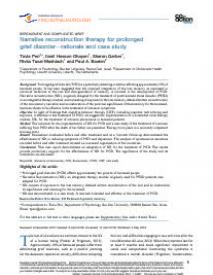Narrative reconstruction therapy for prolonged grief disorder—rationale and case study
Background: Prolonged grief disorder (PGD) is a potentially disabling condition affecting approximately 10% of bereaved people. It has been suggested that the impaired integration of the loss memory, as expressed in recurrent memories of the loss and disorganization of memory, is involved in the development of PGD. Narrative reconstruction (NR), originally designed for the treatment of posttraumatic stress disorder (PTSD) in an integrative therapy module, and consisting of exposure to the loss memory, detailed written reconstruction of the loss memory narrative and an elaboration of the personal significance of that memory for the bereaved, has been shown to be effective in the treatment of intrusion symptoms.
Objective: In light of findings that cognitive behavior therapy (CBT), including cognitive restructuring and exposure, is effective in the treatment of PGD, we suggest the implementation of a somewhat novel therapy module, NR, for the treatment of intrusive phenomena in bereaved patients.
Method: The rationale for the implementation of NR for PGD and a case study of the treatment of a woman suffering from PGD after the death of her father are presented. Therapy took place in a university outpatient training clinic.
Results: Evaluations conducted before and after treatment and at a 3-month follow-up demonstrated the effectiveness of NR in reducing symptoms of PGD and depression. The analysis of spontaneous narratives recorded before and after treatment showed an increased organization of the narratives.
Conclusions: This case report demonstrates an adaptation of NR for the treatment of PGD. The results provide preliminary support for the effectiveness of NR for PGD. The significance of the study and its limitations are discussed.
In: European journal of psychotraumatology, ISSN 2000-8066 | 7 | 1 | mei | 30687
http://dx.doi.org/10.3402/ejpt.v7.30687


